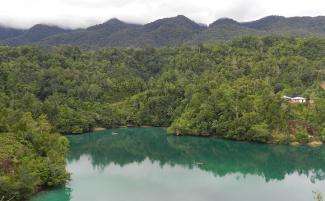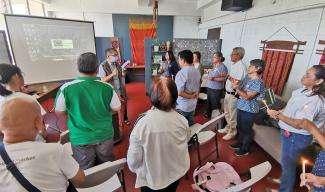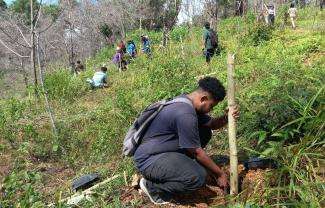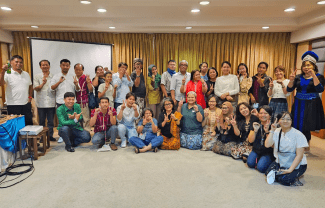Integrating Government Forestry Policy with Customary Justice Systems through Forest Management Units (KPH)
Posting Date
Forest Management Units (KPHs), developed appropriately for the Papuan context, can provide a clear legal space for forestry stakeholders to plan, manage, and improve the value of forests. Designed and executed appropriately, KPHs can also serve as a process and system to rightfully recognise indigenous peoples as land owners and the main stakeholder for responsible forest and land management.
With funding support from the Climate and Land Use Alliance (CLUA) and the Margaret A Cargill (MAC) Foundation, the Samdhana Institute works with the Forestry Department of Papua Province and the Faculty of Forestry at Papua State University to support KPHs as the local forestry locus that integrates national forestry policy with customary land use plans. At the same time, this collaboration provides a chance for a new generation of Papuan foresters to learn about the potential of KPHs in theory and practice.
This work began in 2013 with stakeholder mapping assessments. Samdhana, supporting a KPH in Biak Numfor, conducted field visits and key stakeholder interviews. This KPH in Biak Numfor was established through Ministry of Forestry decision letter No.648/Menhut-II/2010. In December 2011, in accordance to regulation No.61/2010 of the Ministry of Home Affairs, the district government and parliament agreed designate the KPH in Biak Numfor as an local government work unit (SKPD).
The total area to be managed by KPH Biak Numfor is about 206.016 Ha. It is dominated by protection forests that cover 58,41%, followed by 26,76% of limited production forests, and 14,83% of fix production forests. The KPH includes almost 80% of total forest reserve in Biak and Numfor island. Biak Numfor is inhabited soley by the Byak tribe, which structures land use and management through clans.
To better understand the issues and work relevant for KPH Biak Numfor, a stakeholder mapping was conducted. The mapping process looked not only to clarify existing roles and responsibilities, but also assess the knowledge and capacity of various actors in order to inform a capacity building program integrating local law and national forestry regulations for sustainable and legal forestry management. The mapping process furhter helped developed concrete recommendations for strengthening collaboration between different stakeholder groups.
The assessment process also included a series of discussions with partners in Jayapura, Biak, Manokwari, and Jakarta. The discussions focused on developing collaborative programs to support the KPHs and build stakeholder capacity, including programs for coapacity building of indigenous communities. This laid the foundation for a joint project between Samdhana, Papua State University, and the Forestry Department of Papua Province.
Today, KPH Biak Numfor strives to serve as a model for the integration of customary boundary mapping, community participation in forest management, and low carbon forestry development in Papua.
Building on the work of 2013, following activities will be conducted in 2014 in Biak:
With funding support from the Climate and Land Use Alliance (CLUA) and the Margaret A Cargill (MAC) Foundation, the Samdhana Institute works with the Forestry Department of Papua Province and the Faculty of Forestry at Papua State University to support KPHs as the local forestry locus that integrates national forestry policy with customary land use plans. At the same time, this collaboration provides a chance for a new generation of Papuan foresters to learn about the potential of KPHs in theory and practice.
This work began in 2013 with stakeholder mapping assessments. Samdhana, supporting a KPH in Biak Numfor, conducted field visits and key stakeholder interviews. This KPH in Biak Numfor was established through Ministry of Forestry decision letter No.648/Menhut-II/2010. In December 2011, in accordance to regulation No.61/2010 of the Ministry of Home Affairs, the district government and parliament agreed designate the KPH in Biak Numfor as an local government work unit (SKPD).
The total area to be managed by KPH Biak Numfor is about 206.016 Ha. It is dominated by protection forests that cover 58,41%, followed by 26,76% of limited production forests, and 14,83% of fix production forests. The KPH includes almost 80% of total forest reserve in Biak and Numfor island. Biak Numfor is inhabited soley by the Byak tribe, which structures land use and management through clans.
To better understand the issues and work relevant for KPH Biak Numfor, a stakeholder mapping was conducted. The mapping process looked not only to clarify existing roles and responsibilities, but also assess the knowledge and capacity of various actors in order to inform a capacity building program integrating local law and national forestry regulations for sustainable and legal forestry management. The mapping process furhter helped developed concrete recommendations for strengthening collaboration between different stakeholder groups.
The assessment process also included a series of discussions with partners in Jayapura, Biak, Manokwari, and Jakarta. The discussions focused on developing collaborative programs to support the KPHs and build stakeholder capacity, including programs for coapacity building of indigenous communities. This laid the foundation for a joint project between Samdhana, Papua State University, and the Forestry Department of Papua Province.
Today, KPH Biak Numfor strives to serve as a model for the integration of customary boundary mapping, community participation in forest management, and low carbon forestry development in Papua.
Building on the work of 2013, following activities will be conducted in 2014 in Biak:
- Development of indicative maps of clan boundaries inside the KPH
- Completion of a full forest inventory
- Completion of a capacity development plan, including development of a syllabus to be tested in Biak Numfor with Papua State University
- Development of reforestation plots in partnership with indigenous communities
- Completion of opportunity cost assessments for products that can economically, socially, and ecologically benefit KPH stakeholders, including indigenous communities.




